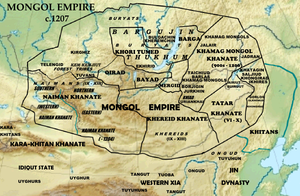Khamag Mongol
Khamag Mongol Хамаг Монголын ханлиг | |||||||||||
|---|---|---|---|---|---|---|---|---|---|---|---|
| 1131[1]–1206 | |||||||||||
The Mongol Confederation ( ) and contemporary polities in continental Asia circa 1200. | |||||||||||
 Constitutive tribes of the Mongol Confederation | |||||||||||
| Status | Khanate | ||||||||||
| Capital | Centered camp near Kherlen River | ||||||||||
| Common languages | Middle Mongol | ||||||||||
| Ethnic groups | Mongols | ||||||||||
| Religion | Tengrism Mongolian Shamanism | ||||||||||
| Government | Elective monarchy | ||||||||||
| Khan | |||||||||||
• 1131–1148 | Khabul Khan (1st recorded Khan) | ||||||||||
• 1148–1156 | Ambaghai Khan (2nd) | ||||||||||
• 1156–1160 | Hotula Khan (3rd) | ||||||||||
• 1160–1171 | Yesugei (de facto) | ||||||||||
• 1189–1206 | Genghis Khan (last) | ||||||||||
| (Minister/Advisor) | |||||||||||
• 1131 – ? | Khaduli Barlas | ||||||||||
• 12th–Century | Erumduli Barlas | ||||||||||
• 1150s–1190s | Suqu Sechen Barlas | ||||||||||
• 1189–1206 | Qarachar Barlas | ||||||||||
• 1190s–1206 | Shigi Qutuqu (last) | ||||||||||
| Legislature | Kurultai | ||||||||||
| Historical era | High Middle Ages | ||||||||||
• Liao dynasty records the existence of the Khamag Mongol | 10th–Century 1131[1] | ||||||||||
• Khabul Khan crowned | 1131 | ||||||||||
• Death of Yesugei | 1171 | ||||||||||
• Temujin becomes Khagan of the Khamag and given honorary name of Genghis Khan | 1189 | ||||||||||
• Jamukha elected as a rival khan to Genghis | 1201 | ||||||||||
• Jamukha defeated by Genghis Khan, who unifies the tribes and establishes the Mongol Empire | 1206 | ||||||||||
| Population | |||||||||||
• 1200[2] | 4,250,000 | ||||||||||
| |||||||||||
| Today part of | China Mongolia Russia | ||||||||||
| History of Mongolia |
|---|
 |
Khamag Mongol (Mongolian: Хамаг монгол, romanized: Khamag mongol, lit. 'the whole Mongol'; Chinese: 蒙兀國) was a loose Mongolic tribal confederation (khanlig) on the Mongolian Plateau in the 12th century. It is sometimes considered to be a predecessor state to the Mongol Empire.[3][4]
The existence of a somewhat mysterious tribal power known in Mongol tradition as Khamag Mongol Uls is recorded in sources of the Khitan-led Liao dynasty.[5] After the fall of the Liao dynasty in 1125, the Khamag Mongols began to play an important role on the Mongolian plains.[6] They occupied one of the most fertile lands of the country, the basins of the river Onon, Kherlen and Tuul Rivers in the Khentii Mountains. The Taichiud (Cyrillic: Тайчууд) was one of the three core tribes in the Khamag Mongol Khanate of Mongolia during the 12th century and whose people lived in the southern part of Siberia's modern-day Zabaykalsky Krai. The present-day Zabaykalsky Krai and the Khentii Province of Mongolia were the core regions of the Khamag Mongol Khanate.[7] The Khamags consisted of the three core clans Khiyad, Taichuud, and Jalairs.
The first khan of Khamag Mongol recorded in history is Khabul Khan from the Borjigin clan. Khabul Khan successfully repelled the invasions of the Jurchen-led Jin armies. Khabul Khan was succeeded by Ambaghai Khagann of the Taichiud. Ambagai was captured by the Tatar confederation while delivering his daughter for marriage to their leadership. He was handed over to the Jin, who cruelly executed him. Ambaghai was succeeded by Hotula Khan, a son of Khabul Khan. Hotula Khan engaged the Tatars in 13 battles in an effort to obtain vengeance for the death of Ambagai Khan.
Khamag Mongol was unable to elect a khan after Hotula died. However, Khabul's grandson Yesugei, who was a chief of the Khiyad tribe, was an effective and preeminent leader of Khamag Mongol. Temujin, the future Genghis Khan, was born into Yesugei's family as the first son in Delüün Boldog on the upper reaches of the Onon river in 1162.
When young Tughril Khan asked for help from Yesugei, the ruler of the Khamag Mongol,[note 1] to dethrone his brothers among the Keraites, the Mongols helped him defeat the Keraite leaders and put him on the throne in the early 12th century.
Yesugei was poisoned by the Tatars and died shortly after in 1171, after which the Khamag Mongol began to disintegrate. Political anarchy and a power vacuum lasted until 1189 when Temujin became the Khan of the Khamag Mongol. War broke soon out between other Mongol tribes. Temujin's friend Jamukha was recognized by the rival tribes as Gurkhan (the universal ruler) in 1201 but he was defeated by the alliance of Khamag Mongol and Keraites.
When Tughril Khan refused to cement the alliance with the Khamag, Temujin's wars with the clans nearly destroyed him. Temujin united all clans on the Mongolian Plateau at last in 1206, when he was given the title Genghis Khan.
See also
[edit]Notes
[edit]References
[edit]Citations
[edit]- ^ 高寳銓. 《元秘史李注補正‧卷一‧合不勒合罕》 (in Chinese).
《源流》作哈布勒汗,《元史》作葛不律寒,錢大昕曰:「寒卽罕之轉音。」蒙古自葛不律始稱汗,銓案原注引《蒙韃備錄》:「舊有蒙古斯國」云云斷爲,卽合不勒稱汗事當金太宗、熙宗兩主天會間,攷宋高宗紹興元年爲金太宗天會九年,歲在辛亥,下距元太祖元年丙寅七十六年,合不勒稱罕宜在其時是也。至孟珙云:「聞蒙已殘滅者。」蓋合不勒歿,俺巴孩嗣,俺巴孩殁,忽圖剌嗣,忽圖刺歿,泰赤烏旋爲太祖所併,時歲在辛酉,下距孟珙辛巳著書之歲二十有一年,故曰久矣,非指金之虜俺巴孩也。
- ^ Journal Smith, John Masson (1975). "Mongol Manpower and Persian Population". Journal of the Economic and Social History of the Orient. 18 (3): 271–299. doi:10.2307/3632138. ISSN 0022-4995.
- ^ Bat-Ocher Bold (2001), Mongolian nomadic society: a reconstruction of the "medieval" history of Mongolia, Richmond, Surrey: Curzon, p. 176, ISBN 0-7007-1158-9
- ^ History of the Mongolian People's Republic By Akademii︠a︡ nauk SSSR, p. 99.
- ^ Khamag Mongol Uls
- ^ Histoire de la Mongolie By László Lőrincz, p. 43.
- ^ History of Mongolia, Volume II, 2003
Sources
[edit]- Akademiiya nauk SSSR – History of the Mongolian People's Republic, Nauka Pub. House, Central Dept. of Oriental Literature, 1973
- Bat-Ochir Bold – Mongolian Nomadic Society, St. Martin's Press, 1999. ISBN 0-312-22827-9
- The New Encyclopædia Britannica, Encyclopædia Britannica, 1974: Macropaedia Me-Ne ISBN 0-85229-290-2
- László Lőrincz – Histoire de la Mongolie, Akadémiai Kiadó,the University of Michigan, 1984. ISBN 963-05-3381-2


 French
French Deutsch
Deutsch
